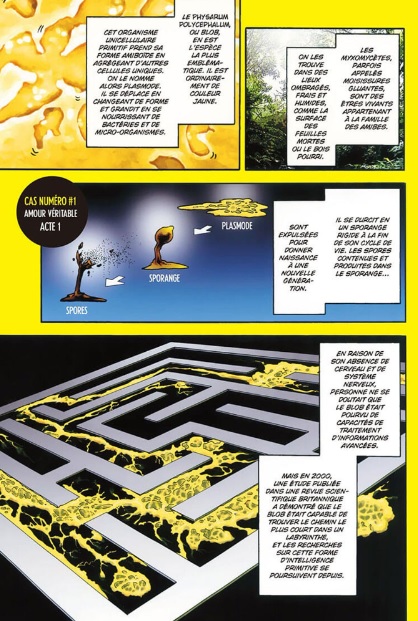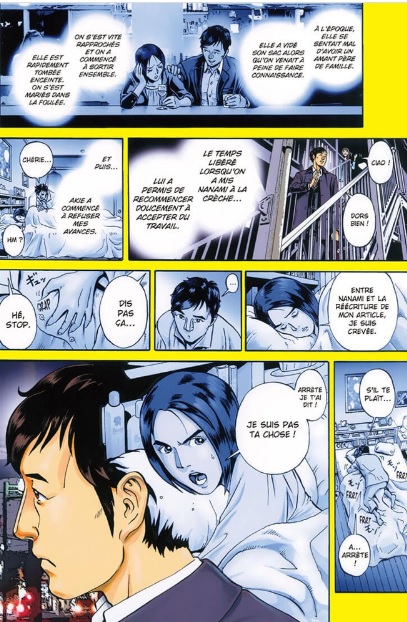This month, crunchyroll editions offer Motoro Mase's latest title, Hitomoji. Its author quickly made a name for himself in the world of seinen manga. Through titles like Ikigami, Demokratia, he tackles heavy subjects such as suicide, the meaning of life, Artificial Intelligence or the meaning of democracy. His eminently political, committed, satirical works tackle as much the problems of Japan as the excesses of the modern world. His latest work offers a vertiginous dive into the world of the pandemic and the anxieties of our contemporary world.
Emotional pandemic
Japan is trembling under the blows of a new disease. Transmitted to humans by the mutation of an amoeba, the myxomycete, the disease strikes anxious individuals. These are transformed into hitomoji, liquefied bodies called plasmode, of which only the head remains human. If nothing is done, this plasmodia hardens into a sporangia before exploding, killing the patient and releasing contagious spores for those who inhale them.
While many people carry the virus, not all develop the disease. Yet the epidemic is progressing. To stop it, the government has formed a medical response team led by Misakai Tamaru. It is up to this brigade to intervene as soon as the slightest case is detected and to try to find a solution, if not a treatment, to stop the advance of this disease.

Race against death
Hitomoji, like the Ikigami series, offers us to follow the daily work of a group of agents. The story takes place, in fact, almost in real time and shows us the management of the multiple cases encountered by these "rescuers". Motoro Mase, thanks to this construction, offers a very rhythmic, dynamic narrative. Our "heroes" are thrown into a race against death. To save the sick, they must dive into their lives and identify the causes of their torment.
The story can therefore be read as an evocation of these times of pandemic when the medical world had to both treat and investigate to understand the origin of Covid 19. It also presents itself as a non-moralizing introspection where patients' lives are dissected to analyze the weight of small decisions, the consequences of the unspoken. The disease thus functions as much as a threat as the necessary element for awareness.

Hitomoji: a horrific representation of an all-too-common evil
This manga is presented as a work of atmosphere that borrows certain codes of horror. Indeed, Motoro Mase chooses to represent a particularly repulsive disease, which melts bodies. We are not far from the imagery of John Carpenter's The Thing . This oppressive dimension is reinforced by the very nature of the contagion: an amoeba, pores. The manga insists on this blind, teeming threat that devours its victims.
This amoeba is not the enemy, however. It is the vehicle for a much more insidious threat: stress. It is an opportunity to talk about a scourge that is ravaging Japanese society but also all developed countries. The author paints a rich picture, taking the precaution of showing our inequality in the face of this threat. In the second part of this volume 1, he takes the opportunity to show the multiple palliatives that Man uses to hide his face and thus cause his death in small doses. The enemy is already there, the amoeba has only made it visible.

Tragically human
Hitomoji builds its plot through several victim characters. This journey into the lands of anguish allows Motoro Mase to apprehend these small worries of human life leading to human dramas. Between the precarious working conditions, the fragility of family life, the heartbreaks, everything is conducive to this disease waking up. But then why do some more than others develop the disease? The author has not yet answered this question except by insisting on the lack of dialogue.
The other important element of this story concerns the view of others and society on these patients. Healthy goods hesitate between rejection, flight, misunderstanding. All are helpless in the face of this silent evil for which no remedy exists, except listening. Similarly, Motoro Mase is interested in the psyche of patients. Healing means accepting that your loved ones see you at their worst, with almost nothing human left. But who is capable of such a choice?
The first volume of Hitomoji confirms Motoro Mase's talent for describing our present world through slices of life. Admirably using our fear of disease, he delivers an exciting story whose development we are waiting to read.















![[Live Report] Rock En Seine 2024 : 20 ans et toujours aussi passionnés !](https://www.justfocus.fr/wp-content/uploads/2024/11/RES24_JOUR01_LANA-DEL-REY_LOUIS-COMAR-12.jpg)




















